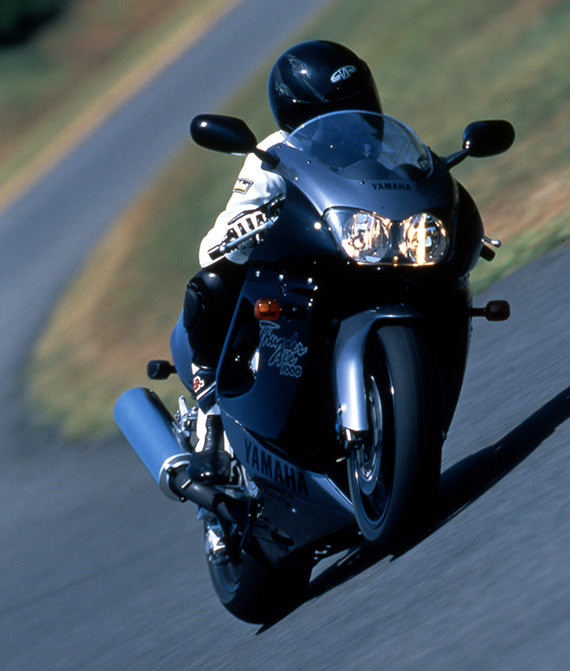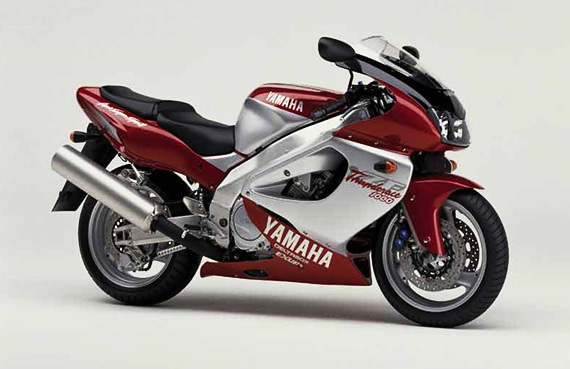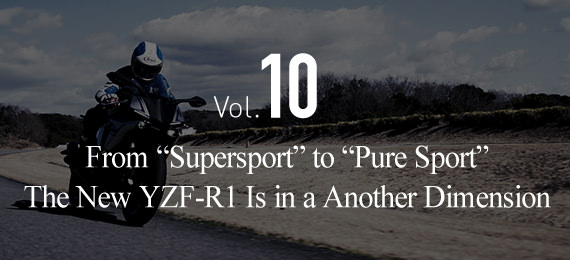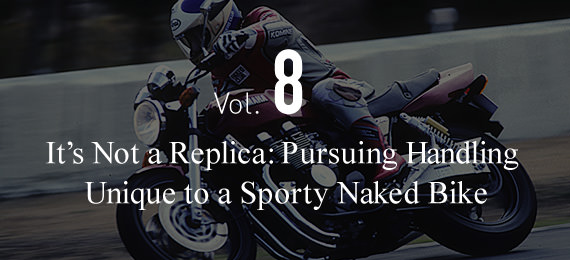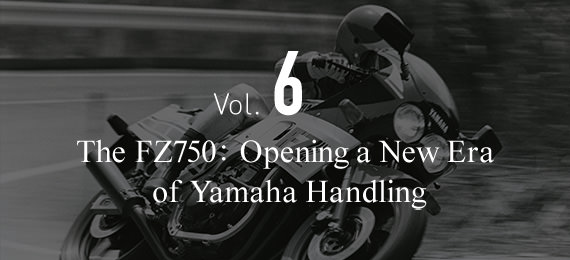Vol.9 The Supersport Transition: From the YZF1000R to the YZF-R1
Throughout its history of sport bike development, Yamaha has always concentrated on handling in tune with the rider’s perceptions. A fine example of this ideal is the YZF1000R Thunderace flagship model released in 1996. The reason was that despite the YZF1000R having the Honda CBR900RR as its principal rival, its Yamaha developers’ primary aim was handling performance that allowed riders to thoroughly enjoy riding on twisty roads with a solid sense of assurance. However, it has to be noted that because of the resulting lack of “stimulation” in the bike’s performance, it received less than enthusiastic reviews when it was first released. In the end though, it became a long-selling model that was praised for its excellent performance as a high-speed tourer, and went on to be loved by motorcycling fans around the world.
Then in 1998, a new model that brought the full wealth of Yamaha’s accumulated knowhow and technological expertise to fruition debuted and sent shockwaves throughout the motorcycle industry: the YZF-R1. A crystallization of the Yamaha ideals of light weight, high power and compactness, this new model gave sport bike enthusiasts a truly high-quality machine with the highest levels of performance, and enabled them to enjoy cornering to their heart’s content on the types of roads and situations where they actually did their riding.
*The article below is a translation of a RIDERS CLUB article originally published in 1998 and contains additions and revisions.
Ken Nemoto
Born in Tokyo, Japan in 1948.
Withdrew from Keio University's Faculty of Letters.
He began riding motorcycles at age 16, won the 750cc All Japan Road Race Championship title in 1973 and competed in the World GP from 1975 to 1978. After returning to Japan, he served as the editor in chief of RIDERS CLUB magazine for 17 years and also served in producing a wide variety of hobbyist magazines. Today, he competes in the AHRMA's classic motorcycle races at Daytona Speedway as part of his life work.
The YZF1000R Thunderace: The Concept of Yamaha Handling Embodied
Ever since beginning the development of sport bikes in the late-1950s, Yamaha Motor consistently sought the type of motorcycle handling that was so well in tune with the rider’s perceptions and expectations that it felt natural and easy to get used to. That unwavering approach to developing this kind of handling led to a distinctive performance quality in Yamaha motorcycles, and at some point, it came to be known among riders as “Yamaha Handling.” While Yamaha stuck to this ideal, there were times when the clearly different handling characteristics of rival manufacturers’ machines would become the focus of popular attention. Even in such times, however, the established concepts of Yamaha-style handling remained firm, because the steadfast approach of Yamaha developers was to always think from the users’ standpoint.
One of the products exemplifying this consistent Yamaha stance is surely the YZF1000R flagship model released in 1996. It was an era when the respective motorcycle manufacturers offered liter-class supersport bikes based on clearly different model concepts. With its CBR900RR that featured a super-lightweight chassis that enabled very quick lean characteristics, Honda surprised the industry and users alike, because this concept had previously been inconceivable in the big-bike category.

The YZF1000R out on the test course (1996)
“While we were still developing the YZF1000R, the CBR900RR had amazed users with its handling, and it was selling very well,” recalls Jiro Izaki (a member of Yamaha’s Road Testing Unit, 2nd Project Engineering Division at the time). He was in charge of track testing for the YZF1000R back then. “It really was a good bike. The feeling of lightness and the stability of its handling was shocking, even to us,” he admits. Izaki went on to explain to us in detail how Yamaha proceeded to develop its own concepts for the style of handling they sought, regardless of what its rivals were doing.
He told us that there was considerable debate within Yamaha at the time concerning whether or not they should pursue the same strategy as the CBR900RR that had become the category leader. There were even some members on the Yamaha testing team who were entranced by the bike. However, a consensus was reached among the testing team that, by their perceptions and standards, the handling of the CBR900RR was simply too “Spartan.”
“The market had accepted the CBR900RR and we couldn’t help but admire the boldness that Honda had shown in going to such lengths to express a new dimension of supersport model appeal and excitement,” Izaki confesses. “However, the point that our discussions always focus on is what performance qualities are important for the way the riders will actually use their bike in touring and the like. From this base point, we draw lines that serve as our judgment standards, and for Yamaha, the kind of Spartan performance we found in the CBR900RR was simply unacceptable by our standards. Still, we decided that Yamaha should also emphasize lightness as the CBR900RR did, in the sense that the bike itself is light, but also feels light when you actually ride it.
“In the advanced development stage for the YZF1000R, we had mounted a 1,000cc engine on a 750cc bike’s chassis and were running track tests [with this pre-prototype]. The 1,000cc engine itself was not that much heavier than the 750cc engine, but when we actually test-rode the bike, we were surprised at how heavy it felt with the 1,000cc engine.
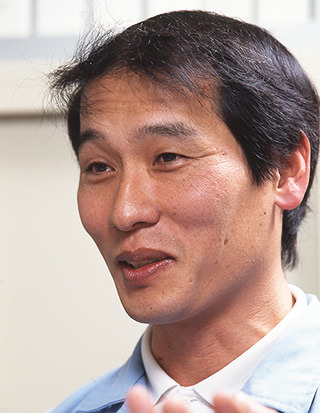
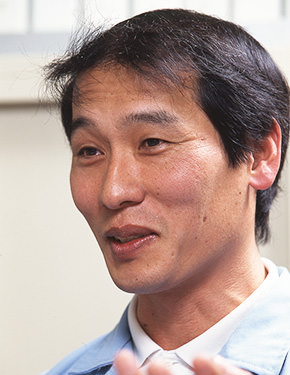
Jiro Izaki, a member of Yamaha’s Road Testing Unit, 2nd Project Engineering Division at the time of the interview
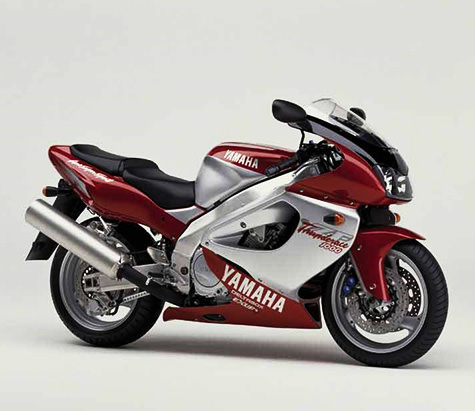
YZF1000R Thunderace (Released in 1996)
Thanks to extensive efforts to reduce weight, the YZF1000R achieved levels of agility that surpassed that of previous Yamaha 1,000cc supersport bikes. Its speed on secondary roads and handling tuned for riding fun made it a model not with the sharp and quick characteristics of a racing machine, but one with a very Yamaha-like set-up that did not make the rider feel anxious. The engine was based on the FZR1000’s and adopted lightweight forged pistons and various other newly designed parts, giving it a maximum output of 145 PS at 10,000 rpm and maximum torque of 11 kgf·m at 8,500 rpm. The front brake calipers’ one-piece construction made them more rigid and lighter, and they boasted excellent usability and anti-fade characteristics.
“The bigger engine had that much of an effect on the bike’s character. The crank of an in-line 4-cylinder engine is heavy, for sure. A motorcycle's lightness and agility doesn’t come from its overall weight alone. When it comes to the character of a motorcycle’s handling in particular, it’s factors other than sheer weight that have greater influence,” continued Izaki. The engine’s power and torque characteristics also greatly affect what and how a rider feels on a motorcycle.
Of course, whether a bike’s ride feels heavy or light is also influenced by its chassis rigidity, wheelbase length, alignment and center of gravity, as well as more detailed specs and settings such as the size of the tires. For example, with chassis rigidity, if it’s too rigid, the bike feels heavy to operate. If the suspension settings are too hard, the result is the same and the bike feels heavy. In short, it’s a matter of finding just the right balance between “too much” and “too little,” and since motorcycles are ridden by people, Yamaha has kept its tradition of finely adjusting performance until it feels in tune with rider perceptions.
“Each rider on our track testing team expresses the relationship between the tires and the road surface through their perceptions as the ‘trail feeling’ or the feeling of contact with the road. Their evaluation of the CBR900RR was that its handling was exceedingly susceptible to kickback. When professional riders are pushing to the limit on the racetrack, having more information conveyed to them from the road can be considered a benefit. However, I don’t think that the average rider on public roads will interpret such information in the same way,” said Izaki, expressing a very Yamaha way of thinking.
“In Europe, there’s not only the Autobahn but also an abundance of incredibly fun winding roads that would make riders in Japan envious. In differentiating them from expressways, we have referred to these winding roads as ‘secondary roads.’
“Beginning with the FZR1000, we made [performance on] these secondary roads our primary focus, and with the YZF1000R that focus was intensified. In order to differentiate our bike from the CBR, it was eventually necessary to clearly define where, and on what kinds of roads we wanted to make our bike most fun to ride,” explained Izaki. “We decided to focus on performance on curves that would be tight and the speeds relatively low for a big bike. In specific terms, that meant winding roads best taken in 2nd and 3rd gear and speeds in the area of 100 km/h.” It was in this kind of environment that they wanted to make the YZF1000R the most fun to ride. The direction they sought with the handling was to get the feeling light enough to make cornering enjoyable but not unexpected and dramatic, thus giving it a feeling of assurance that any rider could easily get used to.
It was these development efforts that led to the market release of the YZF1000R. Weighing just 198 kg, it was unbelievably light for a liter-class bike—especially one with its looks—and it had plenty of power with the engine’s maximum output of 145 PS.
What’s more, its handling was lighter than the FZR1000 but didn’t sacrifice Yamaha’s famed feeling of stability, making the finished product a truly outstanding bike. However, the reviews and reactions that came back from the European motorcycle magazines didn’t rate it as a particularly sensational offering.
“From the way it looked and the feeling of the ride, they seemed to view its positioning as more of a sport-touring bike,” noted Izaki. As one of the leaders of the bike’s development, there was a hint of disappointment in his voice. Nonetheless, the reaction from Europe did nothing to shake the Yamaha values he had always held to. He was already confident that the motorcycle market was entering a new era when users would not look at model specs alone but also take the time to find out what a bike was actually designed for, and judge whether or not it fit their own personal needs.
(Continue to Part 2)



